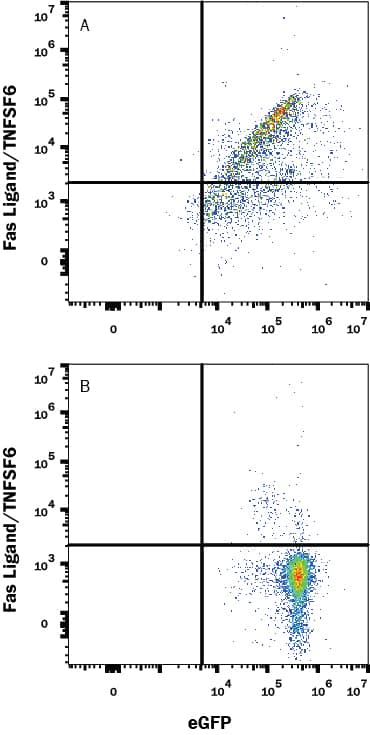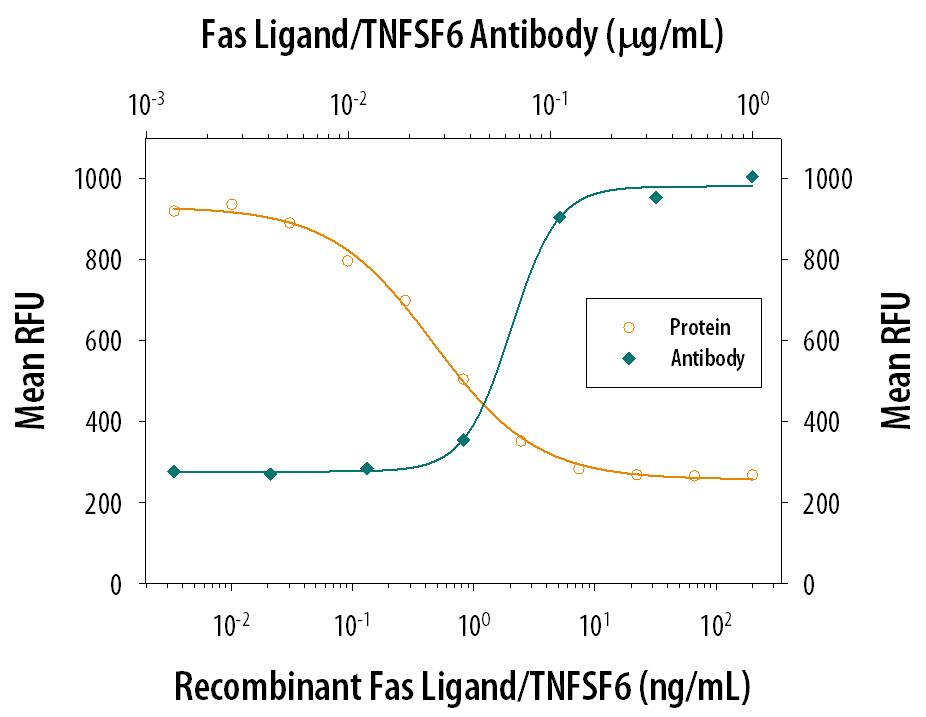Human Fas Ligand/TNFSF6 Antibody
R&D Systems, part of Bio-Techne | Catalog # AF126


Key Product Details
Species Reactivity
Validated:
Human
Cited:
Human
Applications
Validated:
Flow Cytometry, Immunohistochemistry, Neutralization, Western Blot
Cited:
Bioassay, Flow Cytometry, Immunocytochemistry, Neutralization, Western Blot
Label
Unconjugated
Antibody Source
Polyclonal Goat IgG
Product Specifications
Immunogen
Chinese hamster ovary cell line CHO-derived recombinant human Fas Ligand/TNFSF6
Pro134-Leu281
Accession # Q53ZZ1
Pro134-Leu281
Accession # Q53ZZ1
Specificity
Detects human Fas Ligand in direct ELISAs and Western blots. In direct ELISAs, approximately 20% cross-reactivity with recombinant mouse Fas Ligand is observed, approximately 7% cross-reactivity with recombinant rat Fas Ligand and recombinant human (rh) BAFF, and less than 1% cross-reactivity with rhTRAIL, rhTNF-alpha, rhGITR Ligand, and rhAPRIL is observed.
Clonality
Polyclonal
Host
Goat
Isotype
IgG
Endotoxin Level
<0.10 EU per 1 μg of the antibody by the LAL method.
Scientific Data Images for Human Fas Ligand/TNFSF6 Antibody
Detection of Fas Ligand/TNFSF6 in HEK293 Human Cell Line Transfected with Human Fas Ligand/TNFSF6 and eGFP by Flow Cytometry.
HEK293 human embryonic kidney cell line transfected with (A) Fas Ligand/TNFSF6 or (B) irrelevant protein, and eGFP were stained with Goat Anti-Human Fas Ligand/TNFSF6 Affinity Purified Polyclonal Antibody (Catalog # AF126) followed by Allophycocyanin-conjugated Anti-Goat IgG Secondary Antibody (Catalog # F0108). Quadrant markers were set based Goat IgG Control Antibody staining (Catalog # AB-108-C, data not shown). View our protocol for Staining Membrane-associated Proteins.Fas Ligand/TNFSF6 in Human Melanoma.
Fas Ligand/TNFSF6 was detected in immersion fixed paraffin-embedded sections of human melanoma tissue using Goat Anti-Human Fas Ligand/TNFSF6 Antigen Affinity-purified Polyclonal Antibody (Catalog # AF126) at 15 µg/mL overnight at 4 °C. Tissue was stained using the Anti-Goat HRP-DAB Cell & Tissue Staining Kit (brown; Catalog # CTS008) and counterstained with hematoxylin (blue). View our protocol for Chromogenic IHC Staining of immersion fixed paraffin-embedded Tissue Sections.Fas Ligand/TNFSF6 in Human Thymus.
Fas Ligand/TNFSF6 was detected in immersion fixed paraffin-embedded sections of human thymus using Goat Anti-Human Fas Ligand/TNFSF6 Antigen Affinity-purified Polyclonal Antibody (Catalog # AF126) at 15 µg/mL for 1 hour at room temperature followed by incubation with the Anti-Goat IgG VisUCyte™ HRP Polymer Antibody (VC004). Before incubation with the primary antibody, tissue was subjected to heat-induced epitope retrieval using Antigen Retrieval Reagent-Basic (CTS013)). Tissue was stained using DAB (brown) and counterstained with hematoxylin (blue). Specific staining was localized to cytoplasm. Staining was performed using our protocol for IHC Staining with VisUCyte HRP Polymer Detection Reagents.Applications for Human Fas Ligand/TNFSF6 Antibody
Application
Recommended Usage
Flow Cytometry
0.25 µg/mL
Sample: HEK293 Human Cell Line Transfected with Human Fas Ligand/TNFSF6 and eGFP
Sample: HEK293 Human Cell Line Transfected with Human Fas Ligand/TNFSF6 and eGFP
Immunohistochemistry
5-15 µg/mL
Sample: Immersion fixed paraffin-embedded sections of human melanoma tissue and human thymus
Sample: Immersion fixed paraffin-embedded sections of human melanoma tissue and human thymus
Western Blot
0.1 µg/mL
Sample: Recombinant Human Fas Ligand/TNFSF6 (Catalog # 126-FL)
Sample: Recombinant Human Fas Ligand/TNFSF6 (Catalog # 126-FL)
Neutralization
Measured by its ability to neutralize Fas Ligand/TNFSF6-induced apoptosis in the Jurkat human acute T cell leukemia cell line. Cifone, M.G. et al. (1994) J. Exp. Med. 180:1547. The Neutralization Dose (ND50) is typically 0.012-0.072 μg/mL in the presence of 10 ng/mL Recombinant Human Fas Ligand/TNFSF6 and 10 µg/mL of a cross-linking antibody, Mouse polyHistidine Monoclonal Antibody.
Reviewed Applications
Read 1 review rated 5 using AF126 in the following applications:
Formulation, Preparation, and Storage
Purification
Antigen Affinity-purified
Reconstitution
Reconstitute at 0.2 mg/mL in sterile PBS. For liquid material, refer to CoA for concentration.
Formulation
Lyophilized from a 0.2 μm filtered solution in PBS with Trehalose. *Small pack size (SP) is supplied either lyophilized or as a 0.2 µm filtered solution in PBS.
Shipping
Lyophilized product is shipped at ambient temperature. Liquid small pack size (-SP) is shipped with polar packs. Upon receipt, store immediately at the temperature recommended below.
Stability & Storage
Use a manual defrost freezer and avoid repeated freeze-thaw cycles.
- 12 months from date of receipt, -20 to -70 °C as supplied.
- 1 month, 2 to 8 °C under sterile conditions after reconstitution.
- 6 months, -20 to -70 °C under sterile conditions after reconstitution.
Background: Fas Ligand/TNFSF6
References
- Lettau, M. et al. (2008) Curr. Med. Chem. 15:1684.
- Takahashi, T. et al. (1994) Int. Immunol. 6:1567.
- Seino, K-I. et al. (1998) J. Immunol. 161:4484.
- Suda, T. et al. (1993) Cell 75:1169.
- Pitti, R.M. et al. (1998) Nature 396:699.
- Schneider, P. et al. (1998) J. Exp. Med. 187:1205.
- Tanaka, M. et al. (1998) Nature Med. 4:31.
- Chen, J-J. et al. (1998) Science 282:1714.
- Suzuki, I. and P.J. Fink (2000) Proc. Natl. Acad. Sci. USA 97:1707.
- Ferguson, T.A. and T.S. Griffith (2006) Immunol. Rev. 213:228.
- Ryan, A.E. et al. (2005) Cancer Res. 65:9817.
- Takahashi, T. et al. (1994) Cell 76:969.
- Lynch, D.H. et al. (1994) Immunity 1:131.
Alternate Names
CD178, CD95L, FASLG, TNFSF6
Gene Symbol
FASLG
UniProt
Additional Fas Ligand/TNFSF6 Products
Product Documents for Human Fas Ligand/TNFSF6 Antibody
Product Specific Notices for Human Fas Ligand/TNFSF6 Antibody
For research use only
